BY JANET STEINBERG
No, the following is not a joke… but it could almost be told as one on April Fools’ Day! On April 23,1982, Key West, Florida seceded from the United States of America and formed The Conch Republic. Their motto, along with the Conch Republic flag, reads: “We Seceded Where Others Failed”.
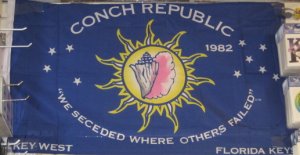
THE CONCH REPUBLIC FLAG
No, it is also not fake news… here are the facts: The trouble began when the United States Border Patrol set up a roadblock and an inspection point on US 1, at the place where the highway connected the Florida Keys to the Mainland. Vehicles were stopped and searched for illegal immigrants and narcotics, thus creating traffic delays and hassles for tourists.
The complaints of the Conchs (Key Westerners’ nickname… pronounced konks) went unanswered, so City Council took the name of the Conch Republic and declared war against the United States. The April 23 war lasted one minute as the city’s Mayor (who was proclaimed Prime Minister) surrendered and applied for one billion dollars in foreign aid. They did not get the billion dollars but they did get a billion dollars worth of publicity.
Cayo Hueso, or “The lsland of Bones” as the 18th century Spaniards called Key West, is located 155 miles south of Miami. The Overseas Highway, sometimes called the “Highway that Goes to Sea”, is 113 miles of roadway (including the Seven-mile Bridge at Marathon) that leapfrogs the Florida Keys to their most southerly point.

CONCRETE BUOY MARKS THE SOUTHERNMOST POINT OF THE CONTINENTAL U.S.A.
The Old Town Trolley and the Conch Tour Train ride along palm-studded streets that shade the pastel retreats that once housed such notables as Ernest Hemingway, Tennessee Williams and John Audubon. “Papa” Hemingway arrived there in 1928 when he was working on “A Farewell to Arms”. It was in Key West that he penned most of his great novels including “For Whom the Bell Tolls”, “To Have and Have Not” and “The Macomber Affair”.
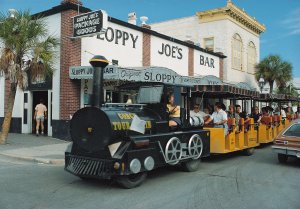
TWO KEY WEST’S FAVORITES: SLOPPY JOE’S AND THE CONCH TOUR TRAIN
A living memorial to the late author has been preserved at his Spanish-colonial mansion. Approximately 40-50 polydactyl (six-toed) cats, descendants of the nearly 50 cats who lived there with “Papa”, still call 907 Whitehead Street home. A discarded Sloppy Joe’s urinal, given to Hemingway by his good friend Joe Russell (owner of Hemingway’s hang-out joint “Sloppy Joes”), was turned into what must be the most famous feline watering hole in the world. An old Spanish olive jar forms the top of the fountain. The trough that forms the base of the fountain is the above-mentioned urinal. Hemingway’s then-wife Pauline surrounded the trough with colorful tiles in an attempt to disguise its true identity.

A PERMANENT RESIDENT OF THE HEMINGWAY HOUSE CASTS AN EVIL EYE UPON A VISITOR
Also noteworthy is a penny embedded in the poolside patio. Having paid $20,000 for the first swimming pool built in Key West (in the late 1930’s), Hemingway took a penny from his pocket, pressed it into the wet cement of the surrounding patio. Hemingway then told his wife: “Well, you might as well take my last cent.” That wife, Hemingway’s second of four, was ultimately divorced. The poolside penny remains.
Harry Truman’s Little White House, which served as the President’s Winter White House, is now an interesting public museum. When you step inside this unpretentious, wooden two-story home, you feel as if you are an invited guest coming to share a meal, listen to a great fishing story, play a game of poker at the round rattan poker table, or hear about important events impacting our country. The furnishings in the home are largely the original furnishings used by the Trumans. On Truman’s mahogany desk is a large green blotter, an ink pen, an inkwell and that famous sign “The BUCK STOPS HERE!”
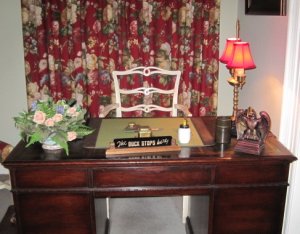
ICONIC SIGN UPON PRESIDENT TRUMAN’S DESK AT THE LITTLE WHITE HOUSE
The Audubon House, where noted artist and naturalist John James Audubon stayed in 1832, was the former home of salvager/harbor pilot Captain John H. Geiger. It was restored some 130 years after Audubon painted some of his renowned birds there. The Geiger tree, featured in Audubon’s painting of the white-crowned pigeon, is in the front yard of the house. Another major attraction in Key West is the Mel Fisher Maritime Museum where you can view the Mother Lode from the treasure-laden Spanish galleon Atocha.
Epitaphs in Key West cemeteries will bring a smile to your face. Carved on the headstone of a widow’s philandering husband is the message: “At least I know where he’s sleeping tonight.” B.P. Roberts’s tombstone reads: “I told you I was sick.”
The Southernmost Point in the continental United States, only 90 miles from Cuba, is marked by a large, red concrete buoy at the corner of South and Whitehead Streets. The small green Mile 0 sign, at the junction of Fleming and Whitehead Streets, marks the southern tip of U.S. Highway 1.

MILE 0 MARKS THE SOUTHERN TIP OF U.S. HIGHWAY 1
You really haven’t been to Key West until you’ve downed a few at Captain Tony’s and Sloppy Joe’s. When Hemingway first came to Key West in 1934, he frequented a rough and tumble fisherman’s saloon at 428 Greene Street. This became the original Sloppy Joe’s Bar, “Papa’s” favorite haunt.
When Sloppy’s rent was raised, owner Joe Russell instructed his patrons to pick up their drinks and bar stools, and they all moved to its present location at 201 Duval Street. The Greene Street saloon then became known as Captain Tony’s.
Call them colorful… call them honky-tonk… or call them tourist traps. Call them whatever you like but, by any other name, Captain Tony’s and Sloppy Joe’s are much more than mere saloons. They are symbolic personifications of Key West itself.

THE FUNKY BAR AT CAPTAIN TONY’S
Whether it’s Conch-Caribbean, Cuban, Chinese, or Classical American food you prefer, you can find them all in Key West. If you don’t mind eating in an unpainted funky driftwood shack, there is B.O.’s Fish Wagon for a fresh fish sandwich served on fresh-baked Cuban bread. A hand-painted sign states: “if it looks like fish, and smells like fish, it ain’t fresh”.
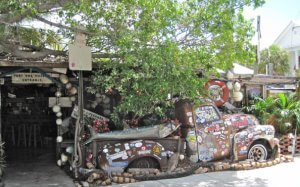
BO’S FISH WAGON
Yes, the sun sets. It happens every night. It happens everywhere in the world. But, in Key West, Florida, it is much more than something that just happens. It is a happening! Sunset at continental America’s southernmost city–that flaming moment when the great orange ball seems to drop off the edge of the universe–is a fiery celebration. It is the sun, the green-blue waters of the Gulf of Mexico, and the people. It is the local Conch, the visitor, the juggler, the belly dancer, and the mime… all of whom gather at Mallory Square Pier for nature’s nightly spectacular.
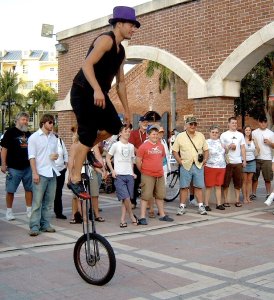
SUNSET AT MALLORY SQUARE PIER IS A NIGHTLY HAPPENING
This island of contrasts is a place where pirates once preyed and presidents once played. It is a place where straight meets gay, where drunk drinks with sober. It is Caribbean and continental, traditional and avant garde. It is the Conch people, conch fritters, conch chowder, the Conch Tour Train, Conch High School, and Conch cheerleaders known as Conchettes. By the time you leave this end of the Florida Keys–this end of the highway–you’re sure to be “conch-ed out”.
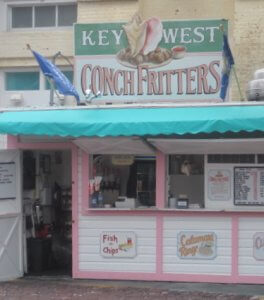
YOU’LL BE CONCH-ED OUT BY THE TIME YOU LEAVE KEY WEST!
JANET STEINBERG, winner of 55 national travel-writing awards, resides in Cincinnati but calls the world her home.
PHOTO CREDITS: Janet Steinberg
